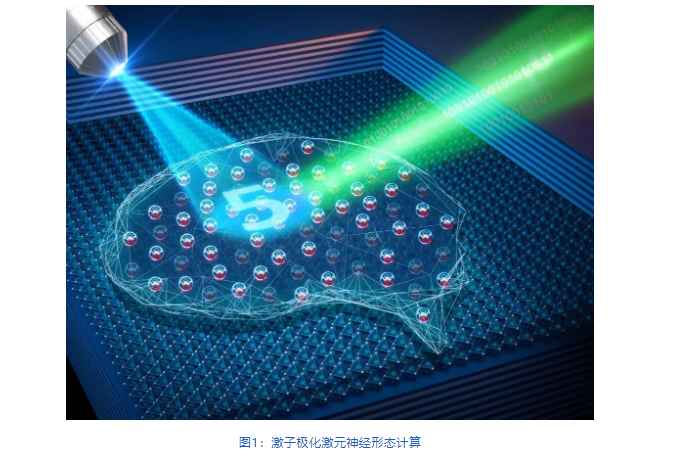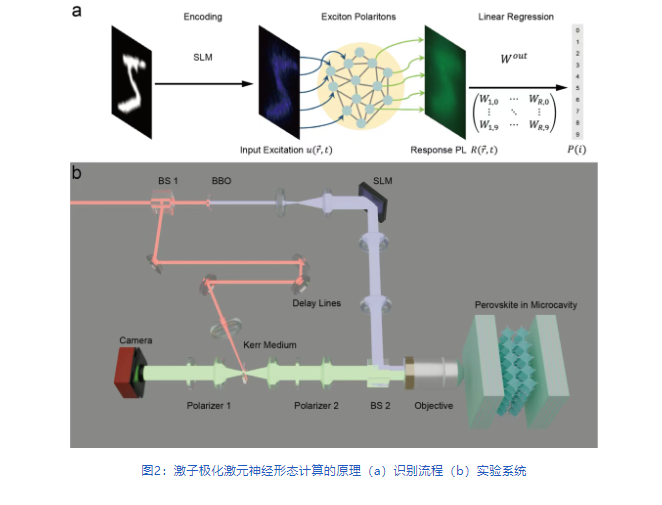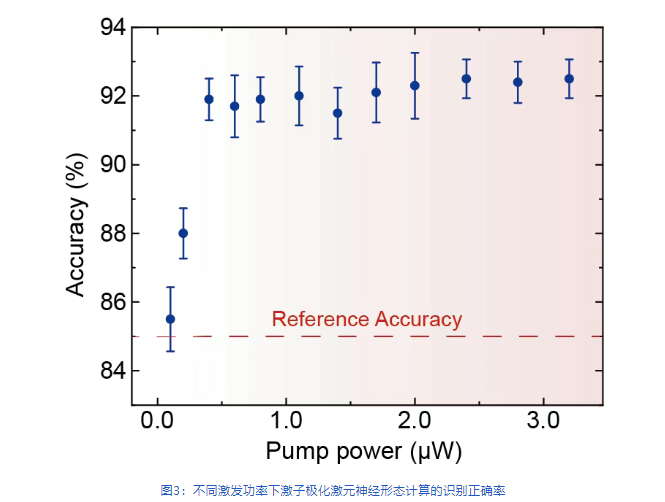02
2025
-
06
Perovskite microcavity exciton polariton neuromorphic computing
Author:
Recently, Professor Xiong Qihua's team at Tsinghua University, in collaboration with the Beijing Academy of Quantum Information Sciences, has built the first room-temperature neuromorphic computing platform based on perovskite exciton polaritons. This platform, without the need for network structure design, can achieve 92% accuracy in image recognition through a single training session. The system features strong nonlinearity, picosecond-level response, and good scalability, providing new materials and implementation schemes for all-optical neural networks, and has significant research and application value. This research work, titled "Ultrafast neuromorphic computing driven by polariton nonlinearities," was published in eLight (selected for two Excellent Plans).
I. Searching for the "Physical Brain" of Artificial Intelligence
Over the past decade, artificial intelligence has made breakthrough progress. Behind applications such as image recognition, speech understanding, and autonomous driving is the continuous improvement of deep neural networks. However, this is supported by massive computing resources and the continuous stacking of high-speed chips.
In reality, training an advanced AI model often requires running hundreds of GPU devices for a long time, consuming enormous energy. This type of computation relies on traditional electronic architectures, which are essentially logical circuits that process information sequentially. They have inherent efficiency limitations when handling complex, parallel, and time-varying tasks.
This has led researchers to consider: Is it possible to break free from the limitations of electronic chips and build a completely new, physical "brain-like computing" system?
Neuromorphic computing aims to mimic the brain's operating mechanism, directly implementing parallel processing and interconnected responses of neural networks at the physical structure level. This not only means higher efficiency but also a fundamentally different "new computing architecture" from existing chips.
II. Light and Matter Superposition States Offer New Ideas
Exciton polaritons are quasiparticles formed by the strong coupling of excitons and photons in semiconductors, combining the high-speed transmission of photons and the nonlinear interaction characteristics of excitons. These quasiparticles have inherent advantages such as parallelism, low power consumption, and ultrafast response, and are considered one of the ideal candidates for implementing neuromorphic computing.
However, existing exciton-polariton neuromorphic computing schemes generally rely on low-temperature operation and complex nanostructure processing, which is not conducive to practical deployment. Whether exciton-polariton-driven neuromorphic computing can be achieved at room temperature has become a key issue in promoting the development of this field.
To address this challenge, Professor Xiong Qihua's team at Tsinghua University, in collaboration with the Beijing Academy of Quantum Information Sciences, has built a neuromorphic computing platform based on perovskite microcavities and exciton polaritons. The team not only conducted comprehensive measurements of the nonlinear response characteristics of room-temperature exciton polaritons but also demonstrated for the first time image recognition tasks without pre-set network structure conditions, achieving an accuracy of 92%, providing new material schemes and experimental ideas for all-optical neuromorphic computing hardware.

III. Implementing Light-Driven Neuromorphic Computing Using Perovskite Exciton Polaritons
The core structure of this platform is a planar FAPbBr₃ perovskite microcavity, which can achieve exciton polariton condensation under non-resonant excitation. The research team used a spatial light modulator to encode MNIST handwritten digit images into spatially modulated excitation light fields and projected them onto the microcavity sample. The perovskite exciton polariton system produces different light emission patterns under different inputs. These light patterns, as output signals, are processed through linear regression to complete classification judgments.

The key to this method is that it does not require pre-setting the topology of the neural network; the computation process relies entirely on the material's inherent information mapping capabilities. In other words, the system directly uses the optical response of the material to realize "network connections," greatly simplifying hardware design and experimental procedures.
In addition, this platform exhibits significant nonlinear characteristics. Experiments show that when the excitation intensity is close to the condensation threshold, the response rapidly transitions from linear to nonlinear, which helps improve the separability between images. Further time-resolved spectral measurements show that the exciton polariton response has a picosecond-level dynamic evolution process, with the potential to process rapidly changing signals.

Figure 3: Recognition accuracy of exciton polariton neuromorphic computing under different excitation powers
IV. Research Highlights and Future Prospects
This work has achieved key breakthroughs in material selection, system structure, and computing performance. The main highlights include:
4.1 Room-temperature operation, breaking the cooling limitation
This platform achieves exciton-polariton-driven neuromorphic computing under room-temperature conditions, significantly reducing system complexity and having the potential for engineering applications.
4.2 Self-generated network, improving scalability
Without the need for a predefined network structure, the system directly implements full-connection mapping through spatial modulation, simplifying the training process and facilitating large-scale integration.
4.3 Dynamic response, supporting time-varying signal processing
The exciton polariton system exhibits picosecond-level response and strong nonlinear characteristics, providing a physical basis for processing dynamic, multimodal inputs.
This research provides ideas for building new light-driven neuromorphic computing chips. Combining the excellent optical properties of perovskite materials with the nonlinear response mechanism of exciton polaritons has not only achieved a transition from "usable" to "practical" but also laid the foundation for achieving high-performance, low-power intelligent optical computing. In the future, this platform is expected to be extended to more complex computing tasks and deeply integrated with photonic device technology, helping neuromorphic intelligence transition from principle verification to practical systems.
LATEST NEWS
2025-12-17
Beijing Institute of Technology Review: Infrared Detectors for In-Memory Sensing and Computing
2025-12-17
High-performance III-V family infrared detectors
Since the advent of infrared detectors in the 1940s, their technological framework has undergone leapfrog development, with significant expansions in both device types and performance.

